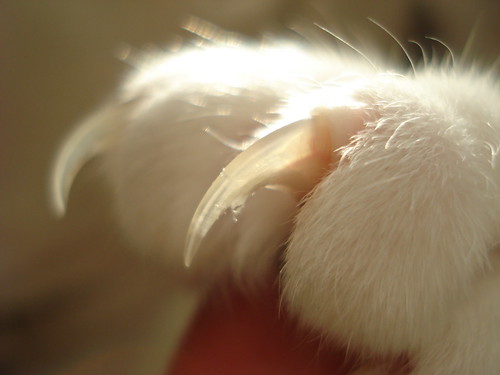 |
| Photo by Monique Jamieson (Click to see original on Flickr) |
The bacteria is spread to cats by fleas and is found in the flea feces, therefore cats that are infested with fleas are more likely to carry the disease. It has been estimated that around 40% of cats have carried the bacteria at some point. Cats scratch themselves and the contaminated flea feces, or “flea dirt,” gets under the cats claws. The bacteria can also be found in the cat’s saliva. When an infected cat scratches or bites a person it can therefore inoculate the person with the bacteria. It has been found that kittens seem to spread the disease more. Since cats do not show any symptoms, you cannot tell which cats carry the disease.
Most people that have the infection have been scratched or bitten by a cat. This often includes children. A papule or pustule may develop at the site of the scratch. Symptoms can take 1-2 weeks or sometimes longer to occur. Typical symptoms include swollen lymph nodes near the site of the wound, usually in the arm, or neck. Some people will experience fever, fatigue, headache, or drainage of the swollen lymph node. Infections are usually self-limiting, meaning it will go away without treatment, and antibiotics are often not recommended. Occasionally other forms with more serious symptoms can occur but these are rare. Immuno-compromised people are more likely to have complications.
There are several ways to avoid catching cat scratch disease. Good flea control for your personal cats (and all pets for that matter) is most important, especially if they go outdoors at all. Avoiding rough play with cats and kittens is also important, because this is usually when bites and scratches occur. Always wash any cat bite or scratch well with warm soapy water and do not let a cat lick any open wounds you may have. Keep your cat’s claws trimmed well. If you develop any of the listed symptoms, contact your doctor.
Written by:
Jennifer Hawthorne, DVM
Lap of Love Veterinary Hospice and In-Home Euthanasia
Dr. Jennifer helps families in the Mecklenburg, Cabarrus and Iredell counties including Charlotte, Concord, Kannapolis, Huntersville, Mooresville and more. Click here to read Dr. Jennifer's biography.


No comments:
Post a Comment
Note: Only a member of this blog may post a comment.